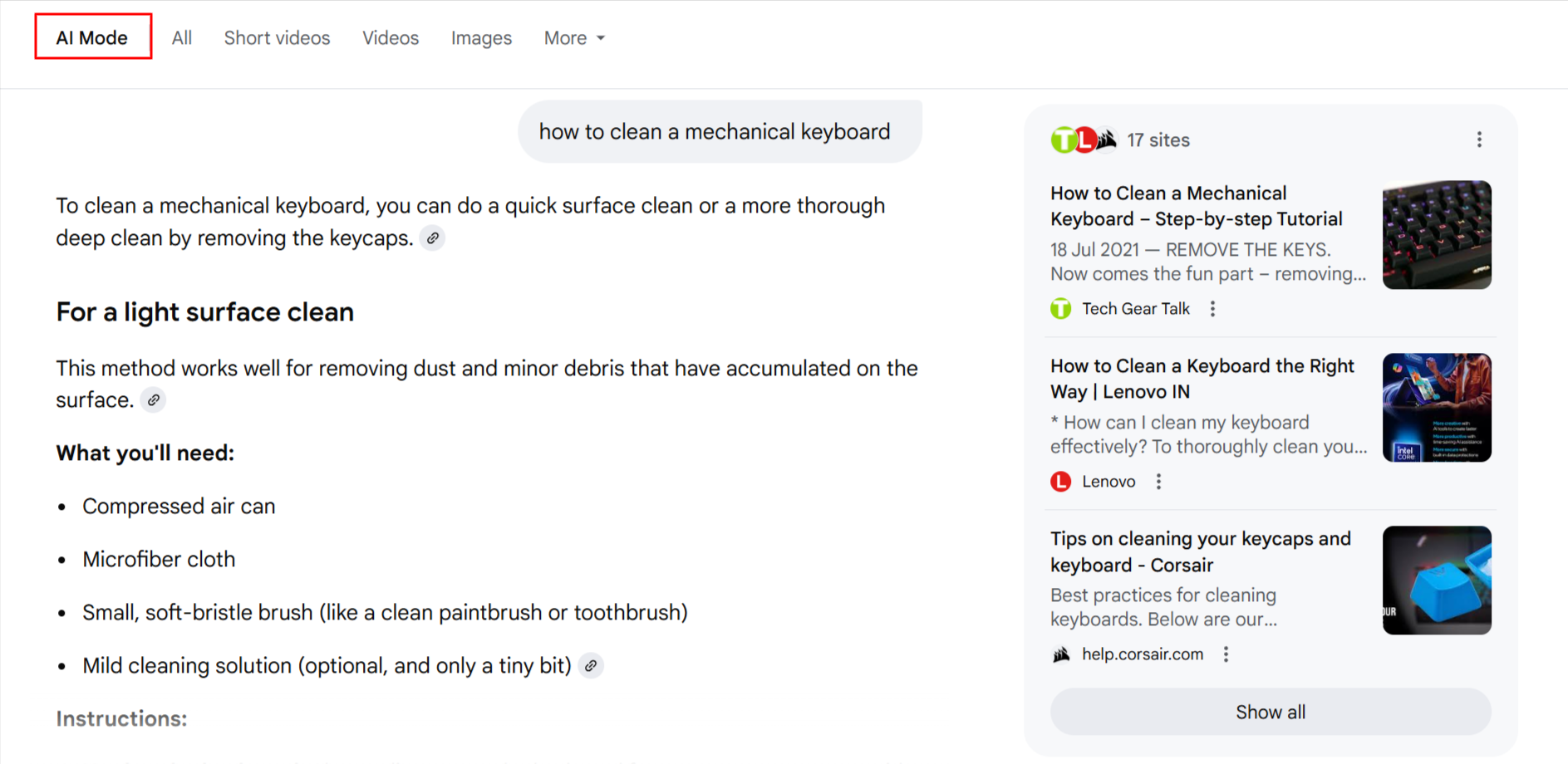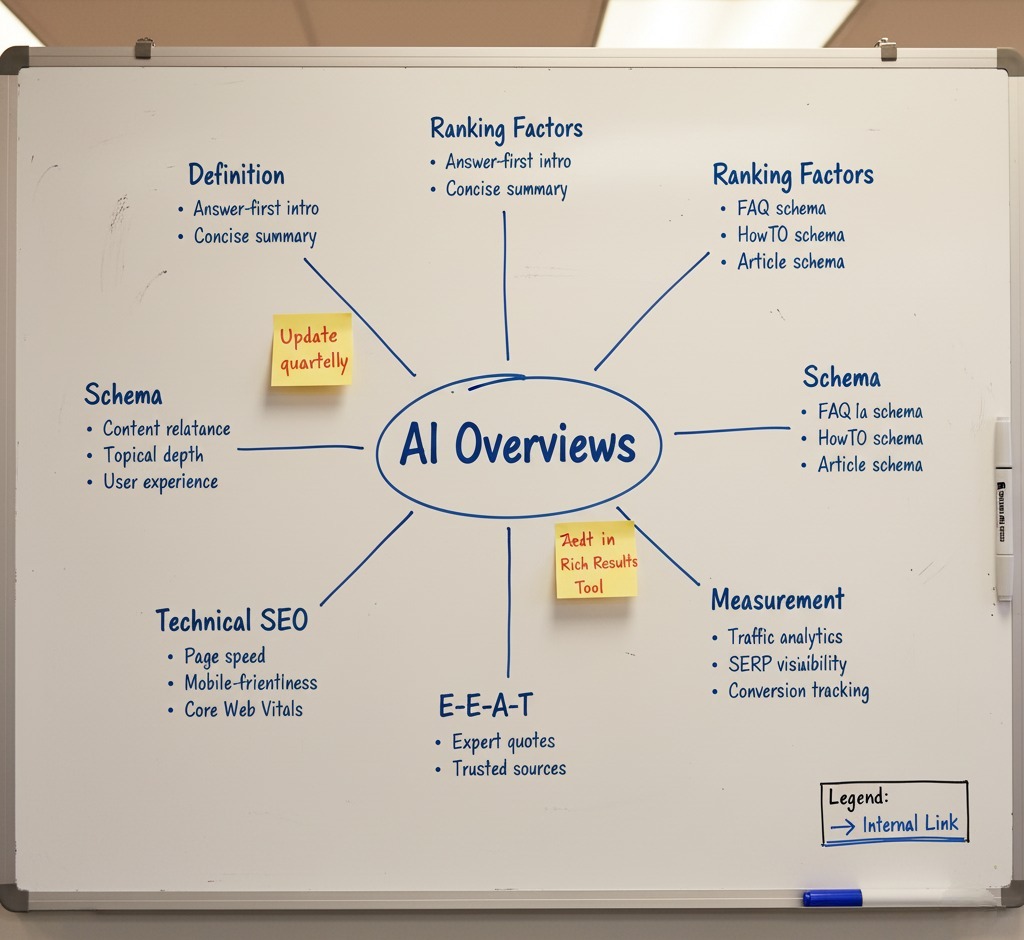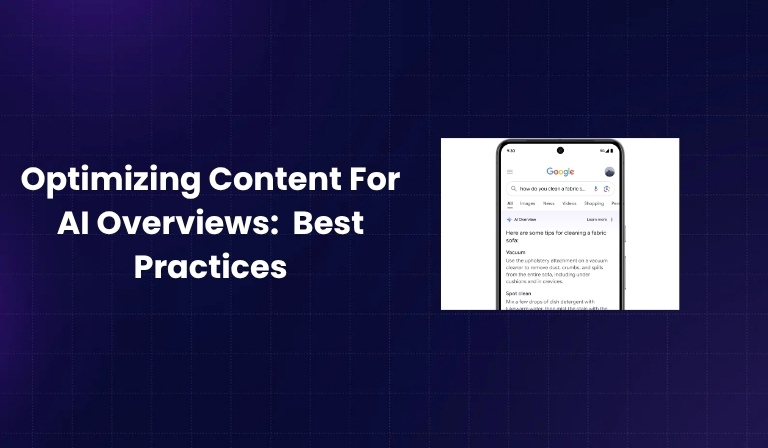AI Overviews are reshaping discovery by surfacing concise, multi-source answers at the top of search results, which means content must be clearer, more credible, and easier for machines to parse while still satisfying human intent. The goal is not just ranking, but being cited and summarized accurately in these AI-generated snapshots.
What AI Overviews change
AI Overviews synthesize answers from multiple trusted pages, privileging content that is precise, verifiable, well-structured, and aligned with intent, while traditional ranking systems and quality signals still matter for inclusion.

Why AI Overviews matters now
Zero-click behavior rises as summaries answer simple queries instantly, so winning visibility requires answer-first writing, rigorous E-E-A-T, strong structure, and technical excellence to be selected as a cited source.
The 7 Best Practices for AI Overview Optimization
Best Practice 1: Lead With Answer-First Structure
- Start pages with a crisp, two-to-three sentence definition or solution that directly answers the primary query, followed by a short TL;DR or key takeaways.
- Use question-style H2/H3s that mirror search intent (What, How, Why, Pros/Cons, Steps, Examples) and deliver the answer immediately before expanding with detail.
- Include a concise FAQ section covering adjacent questions likely to be folded into an overview.
Best Practice 2: Optimize for Semantic Intent, Not Just Keywords
- Build topic clusters around an entity or task and cover sub-intents deeply (definitions, methods, tools, pitfalls, use cases, comparisons).
- Target conversational, long-tail formulations and anticipatory follow-ups a user would ask next; map content to informational, transactional, or local nuances.
- Use natural language, synonyms, and related terms to help models connect concepts without over-optimizing.
Best Practice 3: Use Schema and Clean HTML Patterns
- Mark up content with appropriate schema types (Article/BlogPosting, FAQPage, HowTo, Product, Organization) and ensure valid JSON-LD.
- Structure answers in clean HTML: short paragraphs, descriptive headings, ordered steps, bullet lists, and simple tables that models can chunk without noise.
- Add breadcrumbs, author, and organization metadata for clarity and trust.

Best Practice 4: Maximize Readability and Skimmability
- Write in active voice at an accessible reading level; keep paragraphs to 1–3 sentences and avoid jargon unless it’s defined.
- Present steps, checklists, and comparisons using lists and tables; label visuals with descriptive alt text that matches the section’s purpose.
- Use consistent patterns: definition → quick answer → steps/table → examples → pitfalls → FAQ.
Best Practice 5: Strengthen E-E-A-T and Source Signals
- Show first-hand experience and domain expertise with named authors, credentials, bylines, and editorial review dates.
- Cite primary sources, data, and standards; link out to authoritative references and clarify methods or assumptions.
- Keep content fresh with visible “Reviewed/Updated” stamps; add proprietary insights, original data, or mini-studies to differentiate.
Best Practice 6: Technical Excellence and Performance
- Improve Core Web Vitals, mobile responsiveness, and secure delivery; ensure pages are indexable, canonicalized, and internally linked from relevant hubs.
- Use descriptive, human-readable URLs and tidy markup; avoid intrusive interstitials and heavy scripts that hinder parsing.
- Maintain XML sitemaps, fix crawl errors, and ensure duplication/parameter hygiene to consolidate signals.
Best Practice 7: Measure, Iterate, and Expand Surface Area
- Track queries that trigger AI Overviews, monitor citations/brand mentions, and evaluate downstream engagement quality from these surfaces.
- Run structured experiments on answer placement, schema variations, and cluster depth; refresh high-potential pages quarterly with new data and examples.
- Repurpose authoritative assets across formats (article → how-to steps → table → short video) to increase the ways models can cite the same expertise.
Common Mistakes to Avoid
- Burying the main answer below long intros or fluff; the model may skip buried insights.
- Thin pages that only restate generic information without sources, examples, or first-hand detail.
- Overuse of jargon, complex sentences, or unstructured walls of text that resist chunking.
- Neglecting updates on fast-changing topics, leading to stale or contradictory advice.
How to Measure Success
- Presence in AI Overview citations for target clusters and growth in branded mentions across summaries.
- Improved engagement quality on cited pages: time on page, scroll depth, secondary actions, and assisted conversions.
- Increased inclusion in adjacent SERP features (Featured Snippets, People Also Ask, Top Stories, FAQs), which correlate with overview visibility.
- Content freshness velocity: percent of priority pages updated with meaningful changes in the last 90 days.
Future-Proofing Your Approach
- Design pages to answer multimodal and conversational needs: step lists, visuals, pros/cons, and clear definitions help across voice and chat-style queries.
- Expand clusters with persona-based sections (beginner, advanced, industry-specific) and regional nuances to widen matchability.
- Build brand signals off-site: reviews, profiles, thought leadership, and mentions in reputable roundups help models select trustworthy sources.
Conclusion
AI Overviews reward content that is answer-first, semantically complete, cleanly structured, technically sound, and demonstrably expert. Treat each page as a reliable, easy-to-quote building block within a coherent topical cluster, then iterate based on how and where summaries cite the work.
FAQ
1. How long does it take to be cited?
Inclusion often follows improvements to structure, clarity, and authority, but velocity depends on crawl frequency and competitiveness.
2. Can AI-generated drafts rank?
They can assist, but publication should include expert review, first-hand detail, sources, and clear accountability to meet quality thresholds.
3. Which queries trigger AI Overviews?
Broadly informational and multi-step tasks see the highest frequency, with variance by locale and volatility over time.
4. Do featured snippets still matter?
Yes—earning snippets, PAAs, and top-10 rankings increases the likelihood of being selected as a reliable source in summaries.
5. Should optimization differ by platform?
Core principles persist, but adapt structure and sourcing to each system’s patterns across Google, Bing Copilot, and chat-style engines.

Passionate about blogging and focused on elevating brand visibility through strategic SEO and digital marketing. Always tuned in to the latest trends, I’m dedicated to maximizing engagement and delivering measurable ROI in the dynamic world of digital marketing. Let’s connect and unlock new opportunities together!

